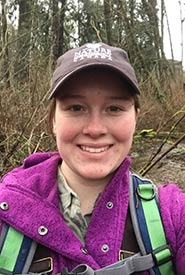Getting my feet wet with field work (literally)
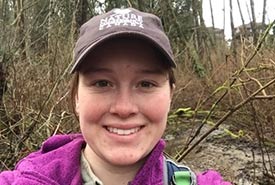
Excited to be in the field (Photo by Lynn Pinnell)
As university students, we learn the theory behind conservation and read journal articles about the findings of studies that took place out in the field, but rarely do we get the chance to participate in real field work.
I feel incredibly lucky to have the opportunity to do a directed studies project with the Nature Conservancy of Canada (NCC). My project involves mapping invasive and at-risk species to determine a species management plan for Centre Creek Conservation Area, located in the suburbs of Surrey, southeast of Vancouver, British Columbia. Not only do I get the opportunity to get out in the field and do hands-on work, but I get school credit for it!
I came into this experience with a love of nature that stemmed from growing up enjoying the outdoors. I translated that passion into studying ecology at university, but with little real field work experience. Taking theoretical knowledge and applying it in the field was a great learning experience. The simple way that books explain how something is done often glosses over how the information was collected. This post will highlight some of my dos and don’ts for other field novices.
1. Preparation
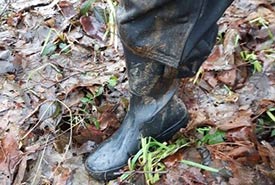
Be prepared. You never know when you will sink in the mud. (Photo by Lynn Pinnell)
Do: Be prepared with the appropriate clothing. Nothing says “first day in the field” like arriving home and having to work hard to remove all the embedded blackberry prickles from your skin.
Don’t: Don’t take your gloves off. That will be the moment that you stumble and grab a thorny bush to catch your balance. Trust me!
2. Mapping
Do: Use mapping software to assist you with planning your route so that you can cover the entire area and record your findings.
Don’t: Get so focused on the map that you lose sight of what you are doing. It’s easy to become so engrossed in the mapping that you spend more time looking at it than for invasive species.
3. Plant identification
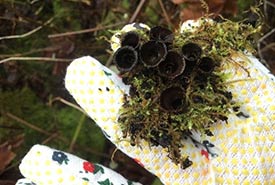
Sometimes you stumble upon neat-looking species. It's best to take a photo to identify it later. (Photo by Lynn Pinnell)
Do: Accept that it’s OK to learn as you go. When I went in the field the first day, I felt confident identifying only three of the many invasive species present in the area. By the end of my field work, I was confident identifying at least 10 invasive species and many more native species.
Don’t: Don’t feel that you must know everything. Take photos of plants and animals that you wish to identify and then try to use reference books and reach out to others to help identify the species. Repeated exposure and learning IDing tricks from different people will help you remember.
4. Flexibility

Sometimes the way forward is blocked and you just have to admit defeat to the blackberry. (Photo by Lynn Pinnell)
Do: Be willing to change your plans as you go. I wanted to walk 15-metre transects (straight lines) along which I looked for invasive species. I soon realized that although that is good in theory, it is impossible to walk in straight lines in dense underbrush, through a natural forest.
Don’t: Don’t get frustrated when the way gets tough. I had many moments when I felt I couldn’t go forward ― quite literally, mind you ― as blackberry stems ensnared me and low-lying tree branches attempted to steal my backpack. Take a moment to breathe and untangle yourself before continuing. Trust me; the attempt to charge onwards when the Himalayan blackberry canes have got you is not in your best interest.
5. Appreciation
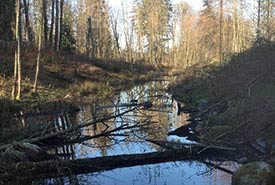
Centre Creek, BC (Photo by Lynn Pinnell)
Do: Take a moment to appreciate the beauty around you. I found that stopping for lunch along Centre Creek and hearing the birds singing hit home ― the work I was doing will hopefully make the area a better home for those animals. I felt honoured to be doing the work.
Field work can be tough, cold, wet and frustrating when you sink below the top of your boots in the mud or get snagged by plants, but the chance to be outside and make a real impact is an incredible gift. I strongly encourage everyone to get involved in a conservation effort, as every little bit makes a world of difference to the species that rely on the area.

